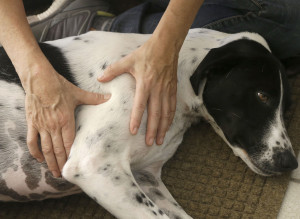
http://www.huffingtonpost.com/2014/11/27/pet-massage-trend_n_6232014.html
Spa treatments don't stop with people. You won't see any aromatherapy candles around, but animals get massages, too, and it's become a regular service that many pet owners value as more than just glorified petting.
"People call me because their dogs are having problems," said Shelah Barr, a San Francisco dog massage therapist. "The work I do is important for animals so they have a high quality of life."
Practitioners say massage can be a preventive measure for younger animals and rehabilitative for older ones by boosting flexibility, circulation and immunity. As its popularity continues to grow, primarily among dog and horse owners, so does the debate about regulation. Some veterinarians argue that pet massage is a form of veterinary medicine that requires a license, but whether therapists need one varies by state. The issue has sparked a lawsuit in Arizona, where three practitioners are suing the state veterinarian licensing board.
Pet owners spent $4.4 billion last year on "other services," a category that includes grooming, training and services such as massage, according to the American Pet Products Association, which tracks national spending trends in the pet industry. That is a 6.1 percent jump from 2012.
Massage sessions can last 30-40 minutes, and therapists travel to homes, hotels and even an owner's workplace, said Barr, who has been practicing in San Francisco since 2006.
"There are a couple of tech companies I go to. They have a quiet office I can go into and work on the animal," said Barr, who typically sees about 15 pets a week.
The treatments don't necessarily mean incense burning around a massage table. Barr is guided by what the dog desires, which sometimes means the pet chews on a bone the whole time.
Grace Granatelli, an animal masseuse in the Phoenix suburb of Scottsdale, said she would play new-age music or "spa sounds," which help relax dogs.
In her sessions, Granatelli would have the dog lie down on the floor or its bed and start by massaging its neck. She would then move to other areas, including legs and hips. But it's not crucial that the dog lie down or sit still.
"There are times where the dog is either very distracted or anxious or isn't quite receptive," Granatelli said. "So I just do the best I can doing the strokes while they're standing — whatever I can do to get the strokes in and get some relaxation in their muscles."
That was until Granatelli became one of three animal massage practitioners who received cease-and-desist letters from the Arizona State Veterinary Medical Examining Board earlier this year. The trio has sued the board, arguing that the statute is overly broad in defining veterinary medicine. They are not practicing while the lawsuit moves through the courts.
The board says "I was doing more than just pampering dogs and that was breaking laws," Granatelli said.
The American Veterinary Medical Association classifies animal massage as a form of veterinary care that should require a license. It is up to each state's veterinary licensing board whether to categorize it that way.
"We do consider them veterinary procedures, and we feel the same standards should be used because a lot of harm can come from them," association assistant director Adrian Hochstadt said.
Carol Forrest, a former client of Granatelli's, said her Dachshunds, Maxie and Lucy, got regular massages for five years. The two, who have since passed away, were able to relax after a massage despite dealing with issues such as arthritis. Forrest said she truly believes massage benefits dogs as much as people.
"It's like if you go to one regularly that you like, they get to know you and you get a better treatment out of it," she said. "The same goes for the dogs ... versus going to the vet — my dogs aren't relaxed at the vet."
Thoughts?

